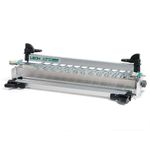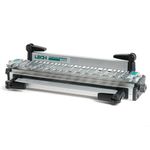A Quick Way to Clean Up Half-Blind Dovetails
Routing away half-blind dovetail waste can be a risky proposition. Mike Pekovich's trick is to add a fence to his router base to prevent routing past the lap line.

This process is similar to my method for routing regular dovetails, but unfortunately a straight bit is the only option for half-blind dovetails. Again, set the bit depth to hit the baseline. But this time, add a fence (pictured above) to the base to prevent routing past the lap line. Get as close to the sidewalls as you dare, but be prepared to do some chisel work to finish up the corners. Use a pair of skew chisels or a fishtail chisel to sever the end grain in the corners where the router bit couldn’t reach, then pare the waste with a bench chisel.

Add a fence to limit the depth of cut. For halfblind dovetails, clamp a fence to the router base to create the inset for the dovetail socket lap.
 |

|
Stay clear of the pins and clean up by hand. With no bearing to guide the way, you’ll have to be careful not to rout into the pins. To clean out the waste after routing, start with a fishtail chisel or a pair of skew chisels and sever the end grain into the corners of the sockets where the router bit can’t reach. Then pare the walls with a bench chisel. Leaving the tape in place during this process makes it easier to check your progress.
From Mike’s article in Fine Woodwork #282 –
 |
All-in-one workstation for dovetailsMike Pekovich’s simple stand holds the work for every step of the dovetailing process. |
More on FineWoodworking:
 |
|
 |
Fine Woodworking Recommended Products

Festool DF 500 Q-Set Domino Joiner

Leigh D4R Pro

Leigh Super 18 Jig








Comments
I’ve never used a router for removing waste from half blind dovetails, but I’m not sure why only a straight bit could be used? It seems to me that one could use a dovetail bit if they wanted... I’m sure I might not be thinking of something, so it’s be nice to clarify that statement.
The problem with straight bits is that when I searched the major manufacturers for their shortest cutter lengths on their top bearing bits, the shortest I could find was 1/2 inch with a 5/8 bearing. Because the whole idea is to have some amount of the top bearing riding along the pin to avoid overshooting and ruining the pins or the baseline, a very specific bit seems to be required for stock under 3/4 thick. That's why I am asking about the bit Mike is shown using in the photo which appears to be a very short cutter length. Using straight bits without bearings for this cleanout task is out of vogue per FWW articles and others due to the inherent danger of botching the cut.
Log in or create an account to post a comment.
Sign up Log in